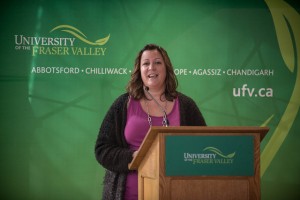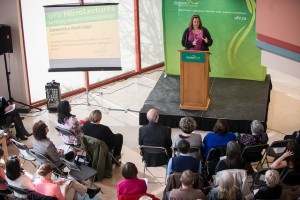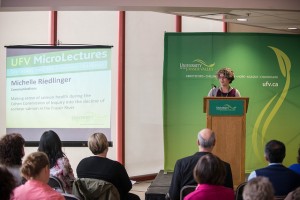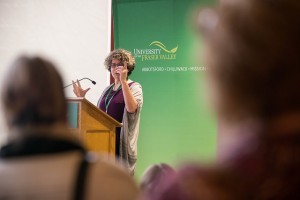Samantha Pattridge and Michelle Riedlinger took up the challenge of speaking for only two minutes at UFV’s Faculty MicroLecture Series this week. They grabbed the stage at UFV’s Roadrunner Cafe and shared some of their findings and the implications of their research. Here are the highlights:
Teaching Communications when you have flipped
 In 2012-13, Linda Pardy and Samantha surveyed four flipped sections of CMNS 251: Professional Report Writing, and one section of CMNS 420: Virtual Team Communication. Their goal was to determine the difference between expected and actual student and instructor workload in a flipped course. They used a strict definition of “flipped”, meaning that students met in class half of the usual three-hour block. They reserved class time for workshops, activities, group work, and peer editing. Any lectures or “content coverage” were handled online.
In 2012-13, Linda Pardy and Samantha surveyed four flipped sections of CMNS 251: Professional Report Writing, and one section of CMNS 420: Virtual Team Communication. Their goal was to determine the difference between expected and actual student and instructor workload in a flipped course. They used a strict definition of “flipped”, meaning that students met in class half of the usual three-hour block. They reserved class time for workshops, activities, group work, and peer editing. Any lectures or “content coverage” were handled online.
Linda and Samantha surveyed students three times during the term: near the beginning to establish their expectations, at the middle, and at the end. Linda and Samantha also kept reflective journals throughout the process.
 Samantha reported on three significant findings:
Samantha reported on three significant findings:
- 70% of the students surveyed expected to spend between one and two hours online per week. But by the end of the course, only 56% reported spending that much time. More students spent three to four hours per week or more than expected.
- As instructors, Linda and Samantha had their own mindsets about teaching that they had to flip. Even if an instructor is accustomed to using active learning strategies in a face-to-face class, the flipped format has new and different demands on how to approach the material with the students. It requires a significant investment of time.
- Only 67% of students overall would recommend a flipped course. The reasons for not recommending it were often related to technology preparedness, but were also related to the ability to be self-directed online. Interestingly, 100% of the fourth-year students would recommend the flipped format. Samantha indicated that instructors must carefully consider the technology skills and academic maturity of students before flipping a course.
Linda and Samantha are presenting their findings at Congress in Calgary in May-June 2016. They also have plans to follow up with journal articles on various aspects of this survey.
Making sense of fishy science
 In 2010, just after Michelle arrived in Canada, the BC government commissioned an inquiry into the dramatic decline of Sockeye salmon in the Fraser River. Michelle said that the transcripts of the testimonies from commission inquiry were a fantastic resource for her because so many different stakeholder groups testified at the commission. As a science communicator, she’s interested in better understanding how the differing perspectives of people shape the ways in which they understand and communicate evidence and risk.
In 2010, just after Michelle arrived in Canada, the BC government commissioned an inquiry into the dramatic decline of Sockeye salmon in the Fraser River. Michelle said that the transcripts of the testimonies from commission inquiry were a fantastic resource for her because so many different stakeholder groups testified at the commission. As a science communicator, she’s interested in better understanding how the differing perspectives of people shape the ways in which they understand and communicate evidence and risk.
Michelle’s study concerned the uptake of new ideas by groups of people with differing practices and values. She looked at the commission testimonies from a point of view of framing (what’s highlighted inside the frame and what’s obscured or outside the frame from the testimonies).
Michelle was particularly interested in the uptake of findings related to salmon anaemia virus genetics, and evidence of this virus in BC. She found that researchers committed to furthering scientific knowledge in general made sense of the findings about salmon anemia virus in terms of the Precautionary Principle and the need to take any evidence of the virus seriously. The researchers also called for more public communication about the implications of the findings. In contrast, researchers stating a commitment to management support for salmon industries spoke about the same research findings in terms of their concerns about “speculative science”. They also saw a need to “manage” public perceptions. Same findings. Different uptake.
 Michelle also found that government research managers attributed a lack of useful ecosystems science happening in the region to the complexity of the science and a lack of adequate resourcing for activities. This research is indeed complex and costly. In contrast, Michelle found that conservation representatives resisted these framings and instead focussed on a lack of Indigenous community collaboration in research and the “politicisation” of science—that the Department of Fisheries and Oceans only fund politically-acceptable scientific research.
Michelle also found that government research managers attributed a lack of useful ecosystems science happening in the region to the complexity of the science and a lack of adequate resourcing for activities. This research is indeed complex and costly. In contrast, Michelle found that conservation representatives resisted these framings and instead focussed on a lack of Indigenous community collaboration in research and the “politicisation” of science—that the Department of Fisheries and Oceans only fund politically-acceptable scientific research.
The Canadian government is promoting the ‘responsible conduct of research’ at the time. In light of this, Michelle believes that research organisations need to consider critical approaches to the communication and the use of research findings more than ever. She is speaking about this research at the 14th Public Communication of Science and Technology Conference in Istanbul, Turkey in April 2016.
Samantha and Michelle found the Microlectures to be a great opportunity to share their research findings with others at UFV. They encourage all UFV students to participate in UFV’s Student Research Day on Thursday, April 7, 2016. Students have three minutes to present their research at this event.
Samantha and Michelle are running a poster planning workshop for students on Friday March 11 from 10:30 am to 12:00 pm in the Kipp Research Lab (B164). Email kelly.tracey@ufv.ca for more details.

So good to have both of you presenting this year. We have some excellent research coming out of the Communications department.